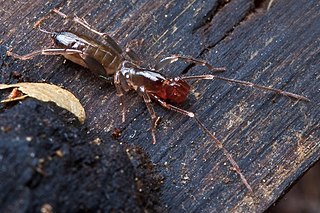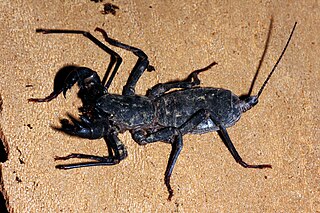
Schizomida is an order of arachnids, generally less than 5 millimetres (0.20 in) in length.

Uropygi is an arachnid order comprising invertebrates commonly known as whip scorpions or vinegaroons. They are often called uropygids. The name "whip scorpion" refers to their resemblance to true scorpions and possession of a whiplike tail, and "vinegaroon" refers to their ability when attacked to discharge an offensive, vinegar-smelling liquid, which contains acetic acid. The order may also be called Thelyphonida. Both names, Uropygi and Thelyphonida, may be used either in a narrow sense for the order of whip scorpions, or in a broad sense which includes the order Schizomida.

Mastigoproctus is a genus of whip scorpions. Native to the tropical forest regions of northern South America, these whip scorpions can reach a length of up to 9 centimetres (3.5 in) and can weigh over 30 grams (1.1 oz). Despite popular belief, they are not venomous as, like all other whip scorpions, they do not possess venom glands.

Mastigoproctus giganteus, the giant whip scorpion, also called the giant vinegaroon or grampus, is a species of whip scorpions in the family Thelyphonidae.

Hypoctonus is a genus of Thelyphonid whip scorpions, first described by Tamerlan Thorell in 1888.

Thelyphonidae is the sole family in the Uropygi order of arachnids.

Thelyphonus is the type genus of whip scorpions or 'vinegaroons' in the subfamily Thelyphoninae, with species found in Southeast Asia.

Typopeltis is an Asian genus of whip scorpions or 'vinegaroons' and currently the only member of subfamily Typopeltinae.

Paracharon is a genus of tailless whip scorpion. A single species, Paracharon caecus has been described. It is endemic to Guinea-Bissau in West Africa It is one of two living genera of the family Paracharontidae, alongside the South American Jorottui. It is a troglobite having no eyes, with P. caecus found living in termite nests.
Etienneus is a monotypic genus of Thelyphonid whip scorpions, first described by Jacqueline Heurtault in 1984. Its single species, Etienneusafricanus is distributed in West Africa.
Glyptogluteus is a monotypic genus of Thelyphonid whip scorpions, first described by Jon Mark Rowland in 1973. Its single species, Glyptogluteusaugustus is distributed in Philippines.
Uroproctus is a monotypic genus of Thelyphonid whip scorpions, first described by Reginald Innes Pocock in 1894. Its single species, Uroproctusassamensis is distributed in Bangladesh, Bhutan, Cambodia, India and Nepal.

Thelyphonellus is a genus of Thelyphonid whip scorpions, first described by Reginald Innes Pocock in 1894.
Labochirus is a genus of Thelyphonid whip scorpions, first described by Reginald Innes Pocock in 1894.
Ginosigma is a genus of Thelyphonid whip scorpions, first described by E. A. M. Speijer in 1936.
Ravilops is a genus of Thelyphonid whip scorpions, first described by Víquez and Armas in 2005.
Mayacentrum is a genus of Thelyphonid whip scorpions, first described by Víquez and Armas in 2006.

Geralinura is an extinct genus in the family Thelyphonidae, commonly known as whip scorpions. Fossil evidence found in the midwestern United States and the United Kingdom indicates that this genus lived during the mid-to-late Carboniferous period. Unlike the subchelate pedipalps of modern whip scorpions, the pedipalps of Geralinura are spiked and non-chelate, suggesting that the modern trait evolved at a later point in time.









